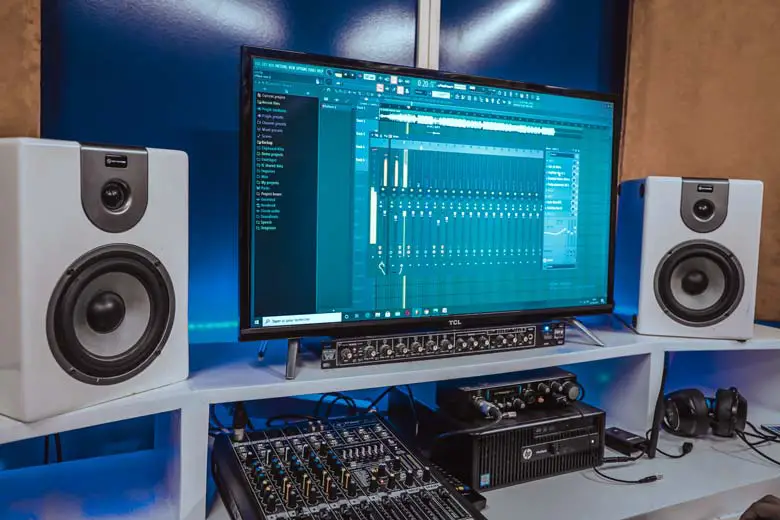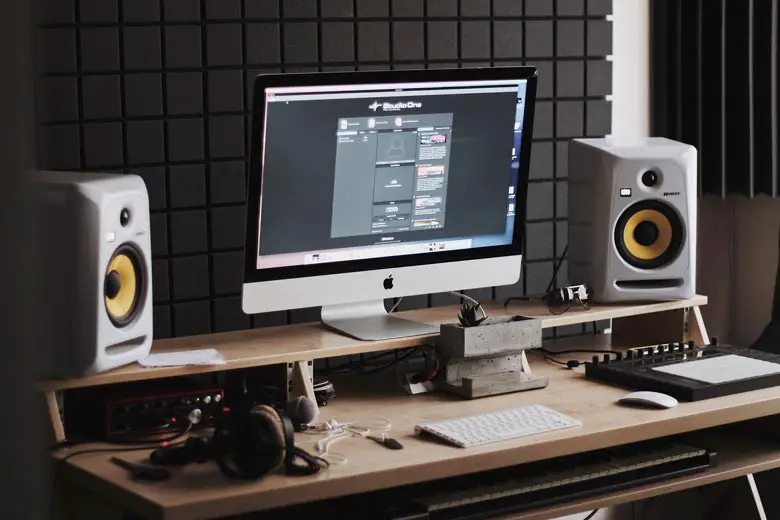When sound engineers are mixing tracks, they use studio monitors. Studio monitors are for professionals, and amateur music listeners prefer home hi-fi speakers. But will hi-fi speakers work in a studio, and can studio monitors be used in your listening room?
You can use hi-fi speakers as monitors by switching an active monitor for a passive hi-fi speaker and provide an amplifier. Many speaker companies sell both home and professional equipment. You can find iconic brands like Yamaha and Klipsch in both homes and studios.
This article will talk about the differences between studio monitors and hi-fi speakers. We’ll provide examples of monitors which have become popular with home audiences and home hi-fi speakers used in some of the world’s most renowned recording studios.
With that information, you’ll better understand where your monitor would work in your home system and your hi-fi speakers in your home studio.

What Is a Studio Monitor?
When audio engineers listen to a track, they want the music with warts and all. After all, you can’t correct mistakes if you can’t hear them.
They pick apart songs, pulling the bass line forward and moving the trumpet back in the mix. Effects like reverb and compression get judged. The engineer adds or subtracts, then plays it again from the beginning.
In this line of work, the surgeon needs their tools to be accurate. Home hi-fi audio designers build speakers to flatter the music. They bump the low end up to fatten the bass and raise the high end to give the impression of added detail.
Recording engineers don’t want the music to sound “better than it is”, as they want their tracks reproduced through their monitors as is.
Home hi-fi speakers generally require an amplifier. Most studio monitors are active speakers that come with built-in amplification.
A passive speaker may sound a little different when you switch to another amp, while an active studio monitor will sound as the designer intended.
The mixer can be confident that their work sounds neither too sweet nor too harsh.
Related article: Can Studio Monitors Be Used As PA Speakers?
Types of Monitors
- Nearfield monitors: Nearfield monitors are small and built for near-field listening. By sitting close to the speakers, the listener minimizes room effects. The music takes a direct path to their ears without bouncing off walls. Acoustic padding absorbs stray echoes to ensure nothing interferes with the engineer’s critical listening.
- Midfield monitors: Not every engineer can work in a small room. Midfield monitors have larger drivers and more powerful amplifiers. They can work well in larger rooms or tracks where the music calls for more bass than a small speaker can produce. A midfield monitor sounds best when listeners are 2 to 4 meters (6.5 to 13 feet) away.
- Far-Field Monitors: Far-Field Monitors are large, bass-heavy, and require lots of open room to breathe. Movie studios use Far-Field Monitors for their sound mixing. Their deep reach allows them to reproduce the sounds of stomping dinosaurs, exploding buildings, and rushing waterfalls as theater patrons will hear them.
Marketing Hi-Fi Speakers
Many home hi-fi speakers appeal to buyers with their beauty. Exotic veneers, race car finishes, and seductive curves are just some of the ways hi-fi designers make their speakers stand out in a crowded market.
Monitors are rarely beautiful, and their boxy lines and plain black finish do not attract the eye but fade into the studio background.
Studio monitors typically are sold in music stores that also carry musical instruments, guitar amplifiers, and professional speakers built for touring bands.
Dealers who sell home hi-fi speakers are more likely to offer equipment designed for home theater and stereo setups.
But that does not mean that you cannot use hi-fi speakers as monitors or monitors in home setups.
Related article: Do Studio Monitors Have Bass? What You Need To Know!

Using Hi-Fi Speakers As Monitors
If you switch an active monitor for a passive hi-fi speaker, you will need to provide an amplifier. If you were connecting to your active monitor via XLR, the standard for most active monitors, you need to ensure that the amplifier has an XLR input.
Once your connections are in order, you can mix your music with confidence. Many professional sound engineers and producers use home hi-fi speakers in their studios. Here are two examples:
Bowers & Wilkins (B&W)
B&W is known for its neutral, balanced sound and the crisp detail of its diamond tweeters. While B&W sells their speakers as home audio, many recording studios use B&W speakers as monitors.
Many classical recording studios use B&W floorstanders like the 800 D3 for Midfields and smaller B&W speakers like the 805 D3 for Nearfield listening.
But Bowers & Wilkins can be found in many famous rock studios as well, including:
Yamaha NS10
The Yamaha NS10, one of the world’s most famous studio monitors, started in 1978 as a bookshelf speaker. But the NS10 sold poorly in the Japanese market, as users complained that it had insufficient bass and piercing, overpowering highs. Then, recording engineer Bob Clearmountain bought a pair.
Clearmountain used the NS10s as reference speakers he could carry with him between recording gigs.
He covered the tweeters with tissue paper to tamp down their brightness and put them on his desk for what would later be called “Nearfield Monitoring.”
Other recording engineers soon followed Bob Clearmountain’s lead. They found the NS10 ruthlessly revealing, but that was part of the appeal. Many joked that if you could make your mix sound good on an NS10, it would work on any equipment.
Since Clearmountain mixed albums like the Rolling Stones’ Tattoo You and Bruce Springsteen’s Born in the USA on NS10s, they may have a point.

Can You Use Studio Monitors As Hi-Fi Speakers?
The NS10 became famous with recording engineers for its challenging sound. A few studio monitors have found love in the home hi-fi community for their pleasant sound.
LS3/5A
In 1975, the BBC needed a loudspeaker for its OB (Outdoor Broadcasting) production vans. The cramped space meant it had to be small, and broadcasting requirements meant the speakers had to reproduce human voices accurately.
When a suitable speaker proved unavailable, the BBC commissioned a prototype.
The LS3/5 proved to be a smashing success. Then, after difficulty obtaining a particular driver in 1977, the BBC altered its original plans. The LS3/5A went on to become one of England’s most popular speakers.
While the original licensees stopped producing the speaker in the late 1990s, several new licensed manufacturers use the old blueprint today to make their versions of the LS3/5A.
JBL L100
When American recording studios needed smaller monitors, JBL gave them the 4310. Released in 1968, the 4310 found its way to major studios like Capitol and Deutsche Grammophon.
Musicians and engineers liked the 4310 so much that they began buying extra pairs for their homes.
Impressed by this demand, JBL released a version of the 4310 aimed at the home market. The L100 used the drivers from the 4310 and was nearly identical in most respects. But to make the L100 more suited for the consumer market, JBL added a burnt orange foam grille (blue and black options were available).
The L100 became even more popular than the 4310. Introduced in 1970, the L100 became the most popular speaker of the decade. In 2018, JBL released an updated version: the L100 Classic.
Related article: Are Studio Monitors Good for Parties?
Conclusion
You can use hi-fi speakers as monitors—and lots of people have! Many home listeners also use monitors as hi-fi speakers.
If you are familiar with the sound of your home hi-fi speakers, you may be able to use them in your studio.